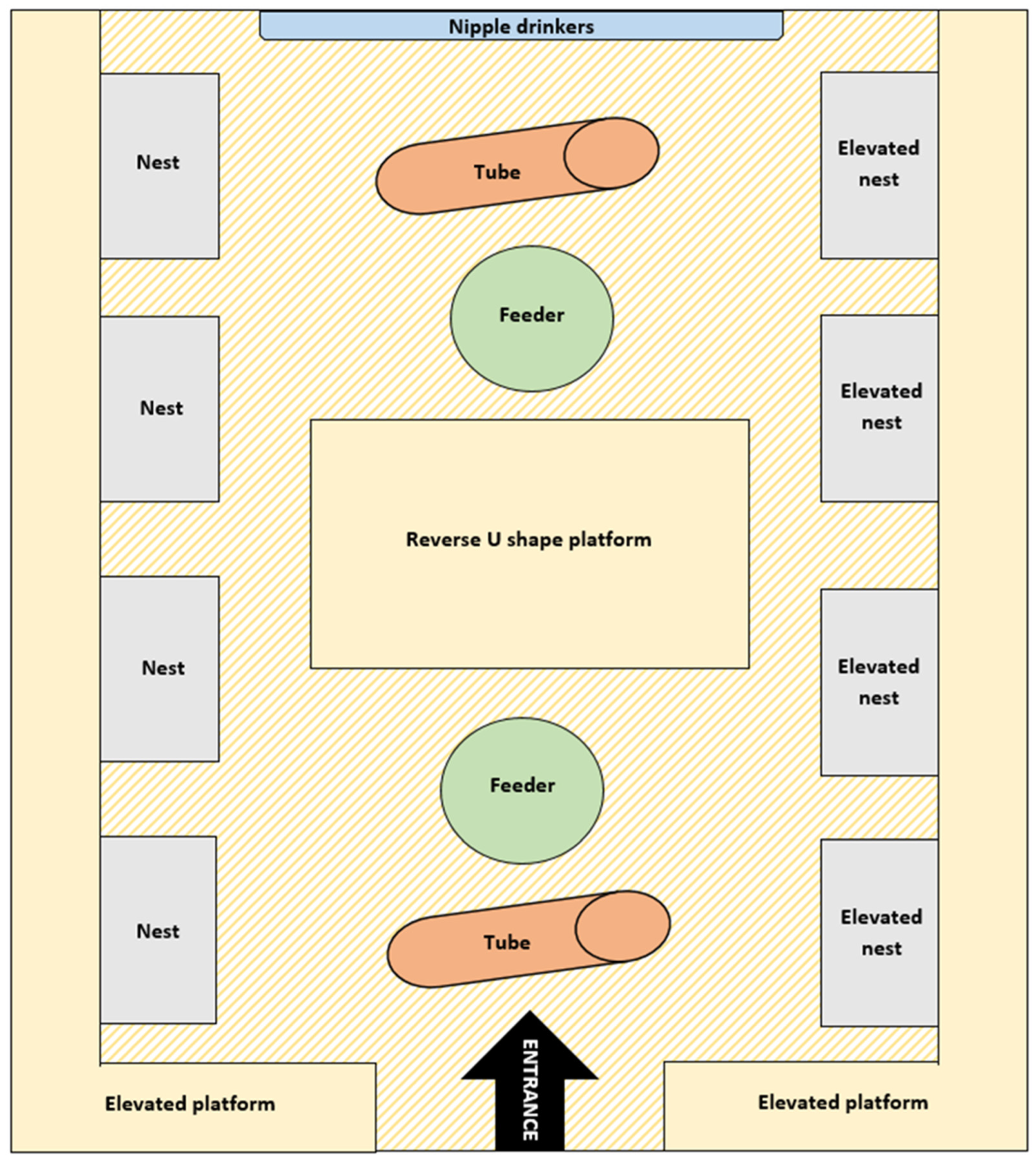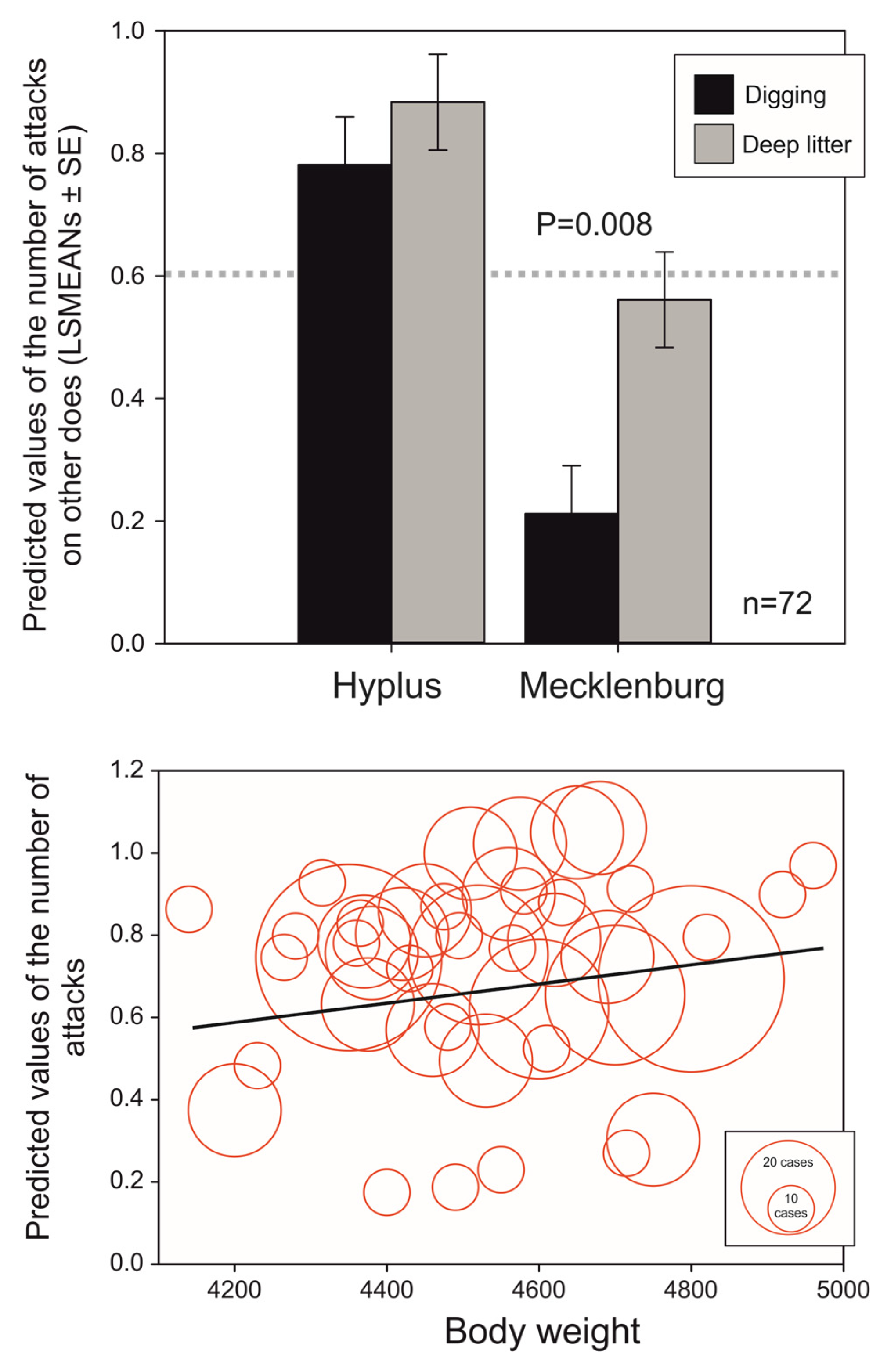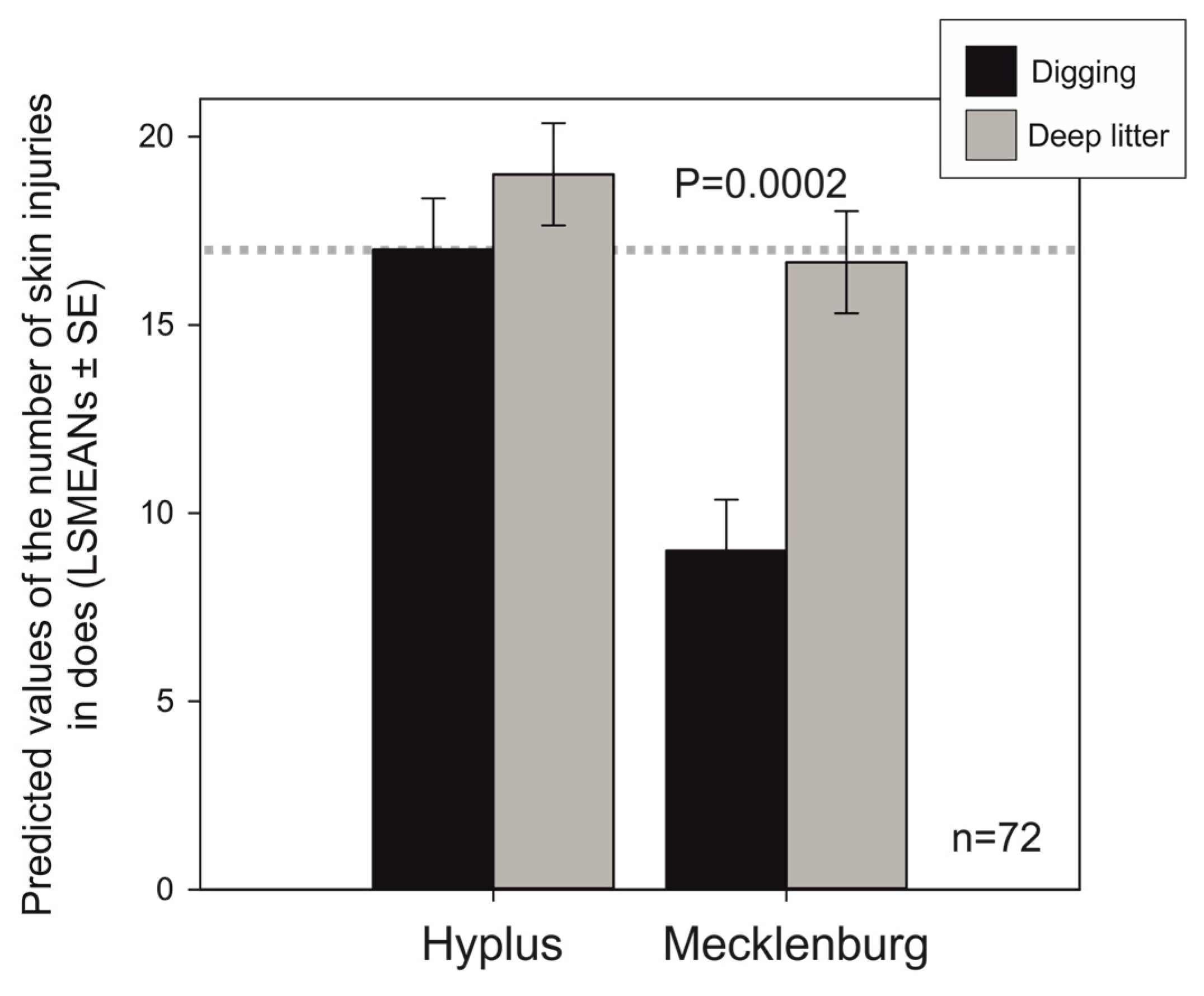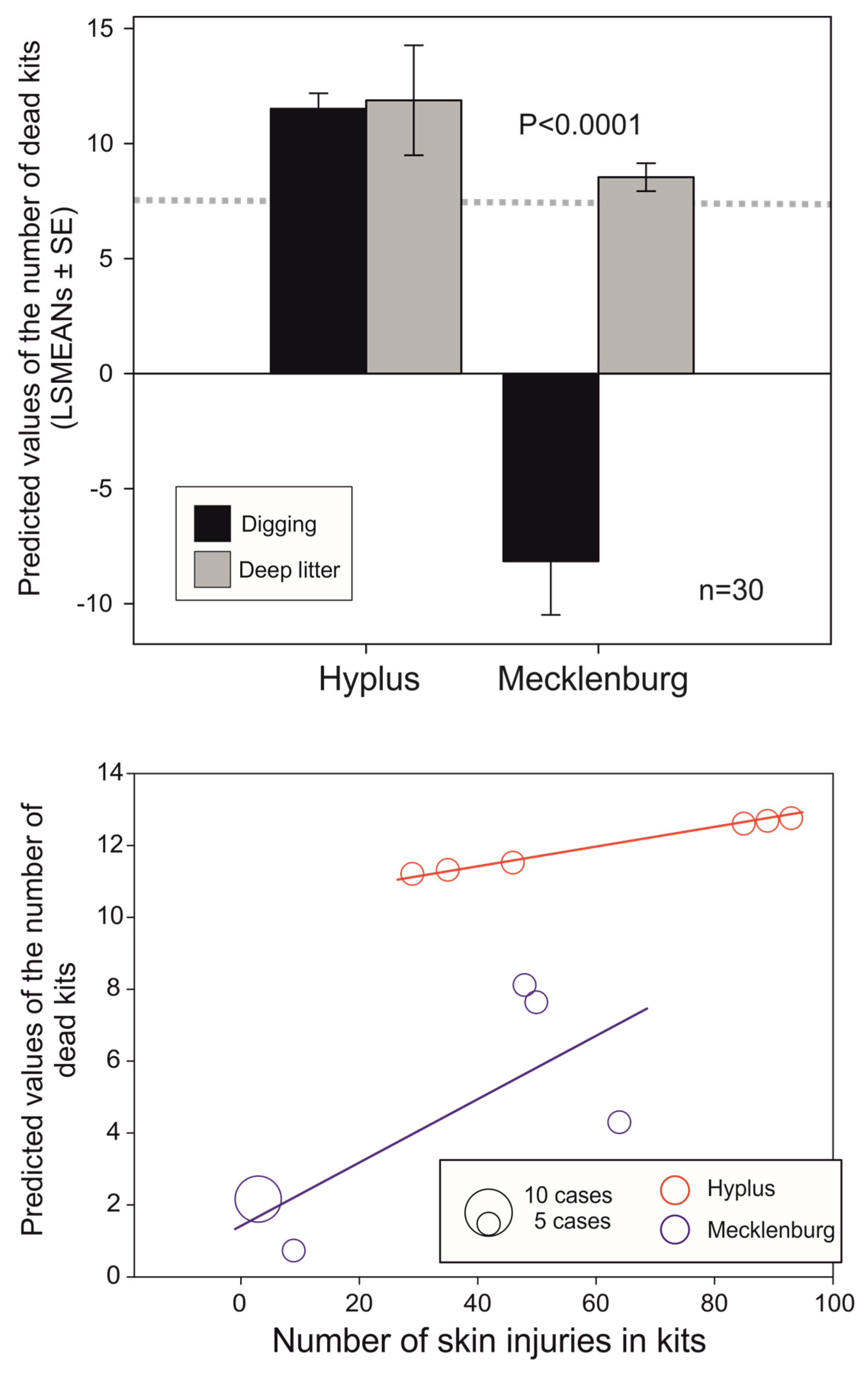Effects of Genotype and Housing System on Rabbit Does’ Aggressive Behaviors and Injuries in Smallholding Conditions
Abstract
Simple Summary
Abstract
1. Introduction
2. Materials and Methods
2.1. Animals and Housing
2.2. Behavioural Observation and Analyses
2.3. Injury Scoring in Does
2.4. Injury Scoring in Kits
2.5. Postnatal Kits Mortality
2.6. Statistical Analyses
3. Results
3.1. Number of Attacks among Does
3.2. Doe Sniffing the Other Does
3.3. Number of Skin Injuries of Does
3.4. Number of Injuries in Kits
3.5. Postnatal Kit Mortality
4. Discussion
5. Conclusions
Author Contributions
Funding
Institutional Review Board Statement
Informed Consent Statement
Data Availability Statement
Acknowledgments
Conflicts of Interest
References
- Bell, D.J. Mate Choice in the European Rabbit. In Male Choice; Bateson, P.P., Ed.; Cambridge University Press: Cambridge, UK, 1983; pp. 211–223. [Google Scholar]
- Mykytowycz, R. Social behaviour of an experimental colony of wild rabbits, Oryctolagus cuniculus (L.) I. Establishment of the colony. CSIRO Wildlife Res. 1958, 3, 7–25. [Google Scholar] [CrossRef]
- Buijs, S.; Keeling, L.J.; Tuyttens, F.A. Behaviour and use of space in fattening rabbits as influenced by cage size and enrichment. Appl. Anim. Behav. Sci. 2011, 134, 229–238. [Google Scholar] [CrossRef]
- Zomeño, C.; Birolo, M.; Zuffellato, A.; Xiccato, G.; Trocino, A. Aggressiveness in group-housed rabbit does: Influence of group size and pen characteristics. Appl. Anim. Behav. Sci. 2017, 194, 79–85. [Google Scholar] [CrossRef]
- Zomeño, C.; Birolo, M.; Gratta, F.; Zuffellato, A.; Xiccato, G.; Trocino, A. Effects of group housing system, pen floor type, and lactation management on performance and behaviour in rabbit does. Appl. Anim. Behav. Sci. 2018, 203, 55–63. [Google Scholar] [CrossRef]
- Gerencsér, Z.; Matics, Z.; Szabó, R.T.; Kustos, K.; Mikó, A.; Nagy, I.; Szendrő, Z. Aggressiveness, Mating Behaviour and Lifespan of Group Housed Rabbit Does. Animals 2019, 9, 708. [Google Scholar] [CrossRef]
- Szendrő, Z.S.; Trocino, A.; Hoy, S.T.; Xiccato, G.; Villagrán, A.; Maertens, L. A review of recent research outcomes on the housing of farmed domestic rabbits: Reproducing does. World Rab. Sci. 2019, 27, 1–14. [Google Scholar] [CrossRef]
- Szendrő, Z.; McNitt, J.I. Housing of rabbit does: Group and individual systems: A review. Livest. Sci. 2012, 150, 1–10. [Google Scholar] [CrossRef]
- Rommers, J.M.; Reuvekamp, B.J.; Gunnink, H.; de Jong, I.C. Effect of hiding places, straw and territory on aggression in group-housed rabbit does. Appl. Anim. Behav. Sci. 2014, 157, 117–126. [Google Scholar] [CrossRef]
- Morton, D.B.; Jennings, M.; Batchelor, G.R.; Bell, D.; Birke, L.; Davies, K.; Eveleigh, J.R.; Gunn, D.; Heath, M.; Howard, B.; et al. Refinements in rabbit husbandry: Second report of the BVAAWF/FRAME/RSPCA/UFAW joint working group on refinement. Lab. Anim. 1993, 27, 301–329. [Google Scholar] [CrossRef]
- European Commission. Overview Report: Commercial Rabbit Farming in the European Union; European Commission: Brussels, Belgium, 2017. [Google Scholar]
- Szendrő, Z.; Szendrő, K.; Dalle Zotte, A. Management of reproduction on small, medium and large rabbit farms: A review. Asian-Australas. J. Anim. Sci. 2012, 25, 738. [Google Scholar] [CrossRef]
- Oseni, S.O.; Lukefahr, S.D. Rabbit production in low-input systems in Africa: Situation, knowledge and perspectives—A review. World Rab. Sci. 2014, 22, 147–160. [Google Scholar] [CrossRef]
- Ruchti, S.; Meier, A.R.; Würbel, H.; Kratzer, G.; Gebhardt-Henrich, S.G.; Hartnack, S. Pododermatitis in group housed rabbit does in Switzerland-Prevalence, severity and risk factors. Prev. Vet. Med. 2018, 158, 114–121. [Google Scholar] [CrossRef] [PubMed]
- Altmann, J. Observational study of behavior: Sampling methods. Behaviour 1974, 49, 227–266. [Google Scholar] [CrossRef] [PubMed]
- Andrist, C.A.; Bigler, L.M.; Würbel, H.; Roth, B.A. Effects of group stability on aggression, stress and injuries in breeding rabbits. Appl. Anim. Behav. Sci. 2012, 142, 182–188. [Google Scholar] [CrossRef]
- Tao, J.; Littell, R.; Patetta, M.; Truxillo, C.; Wolfinger, R. Mixed Model Analyses Using the SAS System Course Notes; SAS Institute Inc.: Cary, NC, USA, 2002. [Google Scholar]
- Rommers, J.M.; Gunnink, H.; Klop, A.; de Jong, I.C. Dynamics in aggressive behaviour of rabbit does in a group-housing system: A descriptive study. In Proceedings of the 17th International Symposium on Housing and Diseases of Rabbits, Fur Providing Animals and Pet Animals, Celle, Germany, 11–12 May 2011; pp. 75–85. [Google Scholar]
- Andrist, C.A.; Bigler, L.M.; Würbel, H.; Roth, B.A. Masking odour when regrouping rabbit does: Effect on aggression, stress and lesions. Livest. Sci. 2014, 170, 150–157. [Google Scholar] [CrossRef]
- Buijs, S.; Maertens, L.; Hermans, K.; Vangeyte, J.; Tuyttens, F.S.M. Behaviour, wounds, weight loss and adrenal weight of rabbit does as affected by semi-group-housing. Appl. Anim. Behav. Sci. 2015, 172, 44–51. [Google Scholar] [CrossRef]
- Braconnier, M.; Gómez, Y.; Gebhardt-Henrich, S.G. Different regrouping schedules in semi group-housed rabbit does: Effects on agonistic behaviour, stress and lesions. Appl. Anim. Behav. Sci. 2020, 228, 105024. [Google Scholar] [CrossRef]
- Castellini, C.; Dal Bosco, A.; Arias-Álvarez, M.; Lorenzo, P.L.; Cardinali, R.; Rebollar, P.G. The main factors affecting the reproductive performance of rabbit does: A review. Anim. Reprod. Sci. 2010, 122, 174–182. [Google Scholar] [CrossRef]
- Rooney, N.J.; Blackwell, E.J.; Mullan, S.M.; Saunders, R.; Baker, P.E.; Hill, J.M.; Sealey, N.J.; Turner, M.J.; Held, S.D. The current state of welfare, housing and husbandry of the English pet rabbit population. BMC Res. Notes 2014, 7, 942. [Google Scholar] [CrossRef] [PubMed]
- Simons, R.L.; Lei, M.K.; Beach, S.R.; Brody, G.H.; Philibert, R.A.; Gibbons, F.X. Social environment, genes, and aggression: Evidence supporting the differential susceptibility perspective. Am. Sociol. Rev. 2011, 76, 883–912. [Google Scholar] [CrossRef] [PubMed]
- Van Abeelen, J.H.F. Effects of genotype on mouse behaviour. Anim. Behav. 1966, 14, 218–225. [Google Scholar] [CrossRef]
- Nie, C.; Ban, L.; Ning, Z.; Qu, L. Feather colour affects the aggressive behaviour of chickens with the same genotype on the dominant white (I) locus. PLoS ONE 2019, 14, e0215921. [Google Scholar] [CrossRef] [PubMed]
- Li, Z.; Zheng, M.; Abdalla, B.A.; Zhang, Z.; Xu, Z.; Ye, Q.; Haiping, X.; Wei, L.; Nie, Q.; Zhang, X. Genome-wide association study of aggressive behaviour in chicken. Sci. Rep. 2016, 6, 30981. [Google Scholar] [CrossRef] [PubMed]
- Vervaecke, H.; De Bonte, L.; Maertens, L.; Tuyttens, F.; Stevens, J.M.G.; Lips, D. Development of hierarchy and rank effects in weaned growing rabbits (Oryctolagus cuniculus). World Rab. Sci. 2010, 18, 139–149. [Google Scholar] [CrossRef]
- Mykytowycz, R.; Dudziński, M.L. Aggressive and protective behaviour of adult rabbits Oryctolagus cuniculus (L.) towards juveniles. Behaviour 1972, 43, 97–120. [Google Scholar] [CrossRef]
- Southern, H.N. Sexual and aggressive behaviour of the wild rabbit. Behaviour 1948, 1, 173–194. [Google Scholar] [CrossRef]
- Rommers, J.; de Greef, K.H. Are combi parks just as useful as regular parks for fatteners for part-time group housing of rabbit does? World Rab. Sci. 2018, 26, 299–305. [Google Scholar] [CrossRef]
- Van Damme, L.G.; Delezie, E.; Ampe, B.; Tuyttens, F.A. Timing of part-time group housing for farm rabbits: Effects on reproductive performance, skin injuries and behaviour. Appl. Anim. Behav. Sci. 2022, 252, 105656. [Google Scholar] [CrossRef]
- Hoy, S.T.; Schuh, D. Sociometric investigations in groups of wild and domestic rabbits with one buck and two or three does. In Proceedings of the 8th World Rabbit Congress, Puebla, Mexico, 7–10 September 2004; pp. 1235–1240. [Google Scholar]





| Countable Variables | Mean | SE 1 | Min | Max | Unit |
|---|---|---|---|---|---|
| Aggressive behaviour | 0.61 | 0.04 | 0 | 7 | Number of cases |
| Sniffing does | 1.18 | 0.07 | 0 | 15 | Number of events |
| Doe injuries | 112.92 | 2.59 | 0 | 330 | Number of injuries |
| Kit´s injuries | 46.17 | 4.01 | 3 | 93 | Number of injuries |
| Kit natality | 38 | 3.98 | 30 | 45 | Number of kits born per group |
| Postnatal kit mortality | 8.08 | 0.61 | 1 | 14 | Number of dead kits per group |
| Doe’s body weight | 4531 | 6.52 | 4140 | 4960 | g |
| Categorical variables | Levels | Description | |||
| Housing | 2 | DEEP 2/DIG 3 | |||
| Genotype | 2 | Hyplus/MC 4 |
| Fixed Effect | Num DF | Den DF | F-Value | p-Value |
|---|---|---|---|---|
| Dependent variable: aggressive behaviour | ||||
| Housing*genotype | 3 | 12 | 14.34 | 0.0003 |
| Body weight | 1 | 62.6 | 4.93 | 0.0301 |
| Dependent variable: sniffing | ||||
| Housing*genotype | 3 | 12 | 2.67 | 0.0946 |
| Dependent variable: injuries in does | ||||
| Housing*genotype | 3 | 68 | 20.40 | <0.0001 |
| Dependent variable: injuries in kits | ||||
| Housing*genotype | 3 | 1 | 4.59 | <0.0001 |
| Litter size | 1 | 60 | 8.71 | 0.0045 |
| Dependent variable: postnatal kit mortality | ||||
| Housing*genotype | 3 | 54 | 43.94 | <0.0001 |
| Number of injuries in kits (genotype) | 2 | 54 | 9.28 | 0.0003 |
Disclaimer/Publisher’s Note: The statements, opinions and data contained in all publications are solely those of the individual author(s) and contributor(s) and not of MDPI and/or the editor(s). MDPI and/or the editor(s) disclaim responsibility for any injury to people or property resulting from any ideas, methods, instructions or products referred to in the content. |
© 2023 by the authors. Licensee MDPI, Basel, Switzerland. This article is an open access article distributed under the terms and conditions of the Creative Commons Attribution (CC BY) license (https://creativecommons.org/licenses/by/4.0/).
Share and Cite
Krunt, O.; Zita, L.; Kraus, A.; Moravcsíková, Á.; Frühauf Kolářová, M.; Bartoš, L. Effects of Genotype and Housing System on Rabbit Does’ Aggressive Behaviors and Injuries in Smallholding Conditions. Animals 2023, 13, 1357. https://doi.org/10.3390/ani13081357
Krunt O, Zita L, Kraus A, Moravcsíková Á, Frühauf Kolářová M, Bartoš L. Effects of Genotype and Housing System on Rabbit Does’ Aggressive Behaviors and Injuries in Smallholding Conditions. Animals. 2023; 13(8):1357. https://doi.org/10.3390/ani13081357
Chicago/Turabian StyleKrunt, Ondřej, Lukáš Zita, Adam Kraus, Ágnes Moravcsíková, Martina Frühauf Kolářová, and Luděk Bartoš. 2023. "Effects of Genotype and Housing System on Rabbit Does’ Aggressive Behaviors and Injuries in Smallholding Conditions" Animals 13, no. 8: 1357. https://doi.org/10.3390/ani13081357
APA StyleKrunt, O., Zita, L., Kraus, A., Moravcsíková, Á., Frühauf Kolářová, M., & Bartoš, L. (2023). Effects of Genotype and Housing System on Rabbit Does’ Aggressive Behaviors and Injuries in Smallholding Conditions. Animals, 13(8), 1357. https://doi.org/10.3390/ani13081357






